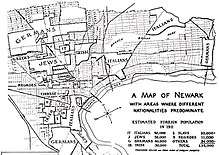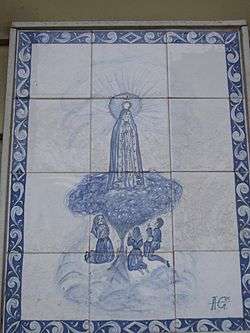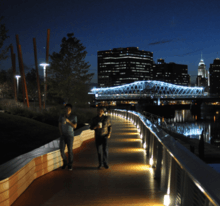The Ironbound
The Ironbound[lower-alpha 1] is a neighborhood in the city of Newark in Essex County, New Jersey, United States.[2][3] It is a large working-class, close-knit, multi-ethnic community & suburb, covering approximately 4 square miles (10 km2) of well maintained streets and homes. Historically, the area was called "Dutch Neck," "Down Neck," or simply "the Neck," due to the appearance of the curve of the Passaic River.[1] The Ironbound is part of Newark's East Ward[1] and is directly east of Newark Penn Station and Downtown Newark, and south and west of the river, over which passes the Jackson Street Bridge, connecting to Harrison and Kearny.


History

The name "The Ironbound" is said to derive from the large metalworking industry in the area or from the network of railroad tracks that surrounded the neighborhood.[1] Balbach Smelting & Refining Company, now the location of Riverbank Park, was the second largest metal processing enterprise in the United States until its closure in the 1920s.[4]
The Ironbound was an industrial neighborhood in the 19th and early 20th centuries. Workers at Benjamin Moore paints, Ballantine Beer, the Murphy Varnish Company and Conmar Zippers lived next to railroad and port workers. The neighborhood was also home to Hensler's Beer Brewery and Pride of Newark ("P.O.N.") beer by the Feigenspan Brewery. The Ironbound was poorer than was the rest of Newark at that time. A legacy of that 19th century poverty can be seen in the neighborhood's architecture - there are very few brownstones or even brick-faced buildings in the district. The inhabitants were considered to be in such need of help that Protestant reformers established the Bethel Mission there in 1850.
As it does today, the Ironbound had inhabitants of many ethnic groups in the 19th century, with Germans, Lithuanians, Italians and Poles being prominent. Lithuanians built the Sacred Heart of Jesus Church in 1894 and Trinity Church in 1902. St. Casimir's Church was founded under Polish auspices in 1908. As an example of the size of the German community in the Ironbound, prior to World War I, Wilson Avenue was called Hamburg Place.
Saloons were major meeting places for Ironbound workers in the era before radio and television. A 1912 survey found 122 saloons in the neighborhood. "The men, after eating a hasty supper in a dirty, crowded home or boarding house," a social worker noted, "quite naturally leave such unattractive surroundings to spend the evenings playing cards and drinking in a warm, well lighted saloon."
The first Portuguese immigrants arrived in the 1910s. By 1921 there was a large enough Portuguese population to found Sport Club Portuguese, the first of over twenty Portuguese social clubs that would call the Ironbound home.

Galician & Jewish immigrants also settled in the Ironbound. In the 1930s Spanish Catholics built elaborate catacombs underneath the Church of the Immaculate Heart of Mary. In the catacombs are placed lifelike wax effigies of saints and martyrs, as there are no burials there. The walls, ceilings and floors of the catacombs are decorated with mosaics and murals. The church above the catacombs was built in the 1850s for a German Baptist congregation, an example of ethnic succession.
In 1983, dangerous levels of dioxin were discovered at an abandoned chemical factory in the Ironbound. The Diamond Alkali Company was largely responsible for this pollution through their heavy production of Agent Orange between 1951 and 1969. The off-site cleanup was completed by 1986, and in 1989 the site received a permanent impermeable cap.
Present day
In 2017,[5] the New York Times described the neighborhood as:
Four square miles populated in large part by Portuguese, Spanish and Latin American immigrants and their descendants, the Ironbound has the intimacy and hustle of a European market town. “We walk to the bakery, the fishmonger, the wine store,” said [the director of the Newark Museum]. (He also walks to work.) “It really is an extraordinarily agreeable lifestyle.”
Portuguese community
Today, the Ironbound is known for being a Portuguese neighborhood.[6] Tap Air Portugal has its corporate office in the neighborhood and the Ironbound Volunteer Ambulance Squad has been serving the community since 1969. Ironbound also has its own newspaper. Many Portuguese still live in Ironbound, but many are moving out to other neighborhoods in New Jersey, Including South River, Livingston, Clark, Westfield, Watchung, Old Bridge, etc.
Portugal Day festival
Every year, people flock to the annual Portuguese Parade & Festival, known as Portugal Day, "Dia de Portugal" (typically held the first or second weekend in June), an enormous celebration of Portuguese culture which attracts nearly half a million people, almost double the population of all of Newark.
During Portugal Day Weekend, many people come out to celebrate Portuguese-American culture. Ferry Street is also the location for most soccer fans to come and celebrate. Fans walk up and down the street while others decorate their cars and celebrate the victory of their soccer team.
Ecuadorian Day festival
(Typically held in the first or second weekend of August), the Ecuadorian Day Parade & festival take place in Ferry Street. In this event various businesses and politicians attend the parade and support the Ecuadorian culture in a statewide recognized festivity. This attracts nearly quarter of a million people to the Ironbound.
Brazilian Day festival
(Typically held in the first or second weekend of September), the Brazilian day festival takes place also in Ferry Street. Various street vendors, musical concerts, and restaurants show support to the Brazilian Culture. This attracts nearly two hundred thousand people to the Ironbound.
Demographics
The Ironbound mainly used to consist of Italians, Polish, Portuguese, and Spaniard Immigrants, as time went on many Italian, and Polish immigrants have moved out of the Ironbound. However there are still some Italians and Polish people residing in the Ironbound. Today's demographics include;
57.46% Caucasian (Mainly consisting of Portuguese, Spaniard, and Italian Ethnicity)
34.94% Latino (Mainly consisting of Brazilians, Ecuadorians, Etc.)
0.95% Asian/American Indian
4.68% Black/African American
1.97% Mixed Race
Parks and Recreation
Independence Park
This park is in the Ironbound district.[7][8] Our Lady of Mt. Carmel, the Ironbound's first Italian parish, faces the park. The church holds an annual Italian Festival which attracts Italian-American people that live in the neighborhood, and Italians who moved out of the Ironbound.[9][10]
Riverfront Park & Waterfront

A chain of parkland along the Passaic River, especially along the downward "curve" in the river that gave the Ironbound neighborhood its nickname of "Down Neck," offers waterfront recreation in the city. Kayaking and riverboat tours of the city are offered in the summer months.[11][12] From east to west along the downward "neck" of the Passaic, parkland includes:
- Riverfront Park, which stretches along the Passaic River offering the "Orange Boardwalk" walkway paths with views of the water.[13][14][15] Red Bull Arena may be seen looking north across the river to the Harrison bank.
- Riverbank Park[16] in the Ironbound along the Passaic River.[17][18]
Education
Public schools
The Newark Public Schools operates six elementary and K-8 schools in the area. Schools serving Ironbound include Wilson Avenue School, Hawkins Street School, Lafayette Street School and Oliver Street School. In addition is Ann Street School, which is considered by many to be one of the best elementary schools in the city and the K-5 South Street School. In fact, Ann Street School received the Blue Ribbon School of Excellence from the US Department of Education. This competitive award had not been awarded to a Newark Public School before. In addition, the award prompted then Vice President of the US, Al Gore, to visit Ann Street to promote the importance of the upcoming 2000 US Census.[19][20] East Side High School serves Ironbound high school students. As of 2004 most of the elementary schools were built over 100 years prior to the time. In the 2000s, an increase in housing lead to an overcrowding of Ironbound-area schools. At the time the school district planned to replace several of the elementary schools and build a new East Side High School in the former Ballantine brewery site.[1]
Private schools
The Roman Catholic Archdiocese of Newark operates the Ironbound Catholic Academy, a PK-8 school in Ironbound.[1][21][22] As of 2004 many residents of Ironbound send their children to parochial schools.[1] Ironbound used to have three other Catholic elementary schools, including Academy of St. Benedict, a PreK-8 school, St. James, both elementary and high school, and St. Lucy Filippini Academy.[1][23] In 2005 the archdiocese announced that St. Casimir, St. Benedict, and St. Lucy Filippini would merge into the Ironbound Catholic Academy on the St. Casimir site.[23] There is also the Our Lady of Fatima Nursery, a Pre-K institution and one Portuguese Language School known at Escola Luis de Camões.
Public libraries
Newark Public Library's Van Buren Branch Library serves the Ironbound neighborhood. The library opened on September 23, 1923. A renovated and expanded branch opened on November 19, 1997.[24]
Popular culture
- Singer-songwriter Suzanne Vega paid homage to this neighborhood in her 1987 song entitled "Ironbound/Fancy Poultry."
- Musician Junior Sanchez was raised here.
- The neighborhood was featured in the 2005 motion picture War of the Worlds, in which director Steven Spielberg used special effects to destroy Five Corners and St. Stephen's Church.
- Jersey Shore singer-songwriter, John Padovano, aka "the Ironbound Crooner" was born in the Ironbound Section of Newark. His album The Return Of Rainy Day Hobo has a song entitled "Oliver Street" that is about his early childhood in the Ironbound.
- Tony Soprano grew up in the Ironbound, as seen in Episode 7 of the first season of The Sopranos, "Down Neck".[19]
- Portions of the 1986 comedy "Wise Guys" were filmed here ( beginning around the 6 min. mark. )
- In the opening sequence of the Alfred Hitchcock thriller "Shadow of a Doubt" the neighborhood that the camera pans into where Joseph Cotton is hiding is the Ironbound.
- The Ironbound has a counterpart in Alderney City in Grand Theft Auto IV, where a neighborhood called Leftwood appears to have a large Portuguese population including heritage and language deriving from Portugal.
- The popular Pages of Ferry Street literary reading series highlights Portuguese-American writers, with the first reading in June 2012 at the Sport Club Português, featuring Portuguese writer Jose Luis Peixoto and Ironbound born Carlos J. Queirós; In 2013, the Ferry Street reading included Paula Neves and Millicent Borges Accardi.
- Heavy metal band Overkill released their 15th album titled Ironbound in 2010. Much of the album's lyrical theme, especially the title track, surrounds the topic of the local area and its people.[25]
- Poet Deborah Corona LaVeglia, who attended Lafayette St. School and East Side High School is author of "Vigil" and often writes about growing up in the Ironbound area.
See also
- Newark Ironbound Express
- Newark Riverfront Park
Notes
- Often referred to with a definite article, e.g., The Ironbound.[1]
References
- Lawlor, Julia. "If You're Thinking of Living In/The Ironbound; A Home Away From Home for Immigrants", The New York Times, January 11, 2004. Accessed June 26, 2013.
- Lasky, Julie (1 March 2017). "The Ironbound, Newark: Convenient, but a World Apart". Retrieved 11 February 2018 – via NYTimes.com.
- https://www.wsj.com/articles/SB10001424052748703886904576031681807027592
- J. Bennett. "Riverbank Park in Newark". Newarkology. Archived from the original on September 25, 2015. Retrieved October 29, 2015.
- The Ironbound, Newark: Convenient, but a World Apart https://www.nytimes.com/2017/03/01/realestate/the-ironbound-newark-convenient-but-a-world-apart.html
- Shepard, Richard F. "EXPLORING THE CULTURAL PLEASURES OF NEWARK - April in Portugal is Waiting Just Across the Hudson", The New York Times, March 26, 1982. Accessed June 26, 2013.
- https://www.essexcountyparks.org/parks/independence-park
- https://goo.gl/maps/ZtVYzxvHXYL2
- http://www.newarkhistory.com/independencepark.html
- https://www.facebook.com/OLMCNEWARK/
- http://newarkriverfront.org/events/kayaking/
- https://www.newarkhappening.com/things-to-do/waterfront/boat-tours/
- https://www.essexcountyparks.org/parks/riverfront-park
- https://goo.gl/maps/vCGV8Nq1GKF2
- https://www.newarkhappening.com/things-to-do/waterfront/
- https://www.essexcountyparks.org/parks/riverbank-park
- https://goo.gl/maps/1FsXS9zghwn
- Minish Park, https://goo.gl/maps/R3ZAJNp9mYD2
- Erminio, Vanessa. "Neighborhood snapshot: Ironbound", The Star-Ledger. November 8, 2007. Accessed June 26, 2013.
- "Newark Public Schools 2008-2009 Directory Archived 2010-11-04 at the Wayback Machine." Newark Public Schools. Retrieved on March 2, 2010.
- "St. Casimir Academy." St. Casimir Roman Catholic Church. Retrieved on March 2, 2010. "The mission of the Christian Community of St. Casimir Academy(Pre-Kindergarten through Grade 8), calls us to serve the children within the Ironbound area of the Newark Archdiocese by providing them with a total education based on the teachings of Jesus, through which Christian principals and moral values become a part of each students character and life."
- "Essex County Catholic Elementary Schools Archived 2010-02-14 at the Wayback Machine." Roman Catholic Archdiocese of Newark. Retrieved on March 2, 2010.
- "New Jersey: Newark: Seven Catholic Schools To Close", The New York Times. March 3, 2005. Retrieved on March 2, 2010.
- Van Buren Branch Library, Newark Public Library. Retrieved on March 2, 2010.
- "Ironbound: A Track-By-Track Blitz".
Further reading
- Collins, Glenn (1991-03-29). "Newark's Unsung Delights". New York Times. Retrieved 2020-06-25.
The Ironbound, [...] Head out the Raymond Plaza East exit
- "Portugal in Newark" - The Star-Ledger and The Newark Museum (also at Archive.is)
External links
- Ironbound Community Corporation
- OLA Official Ironbound District Magazine
- Ironbound Business Improvement District
- Ironbound Community Corporation - a non-profit organization in the community
- Star-Ledger Article about the Ironbound catacombs
- A tour of the Ironbound's Riverbank Park
- A tour of McWhorter Street
- A tour of Fleming Avenue
- "Ferry Street." Newarkology! September 29. 2007 October 14.
- Map: 40°43′30″N 74°09′40″W
